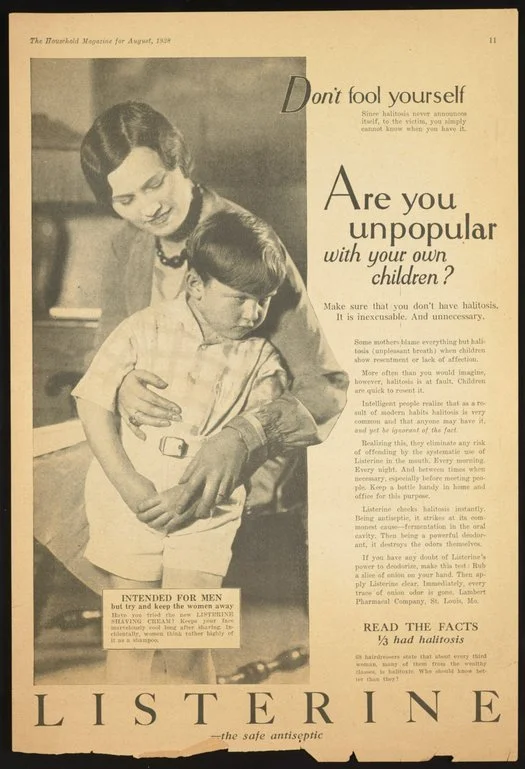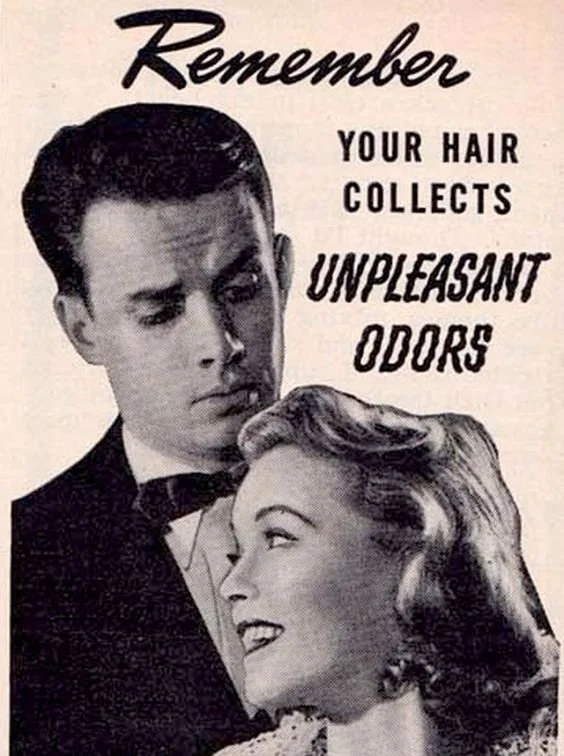Fear, guilt, and shame sell. But at what cost?
Inviting integrity and human connection back into our marketing.
I remember the first time someone pitched me. I was working at an art store. It was my first “real” job, with shifts and a pay stub. During a lull, a man walked in selling some sort of bundle of wellness-related products with micronutrient-this and ultra-hydrating-that. His argument was very persuasive, replete with what I now know to call social proof, scarcity, and urgency. And as I listened, I felt more and more compelled to buy this [highly-inflated] package.
So I did.
And immediately regretted it. But poof! He was gone.
At the time I saw it as a fault on my end. I was too trusting. (I made a note to self to work on that.) Now I understand it differently; I was a young, unsavvy minimum-wage earner, who, for the first time, had some semblance of disposable income.
I was vulnerable, and had just officially become fair game. And it’s been game on ever since.
NOW…
Twenty years later, I am on the other side, and I keep finding myself checking in with my teenaged self:
Am I marketing to others the way I’d have wanted her to have been marketed to?
FEAR, GUILT & SHAME: WHAT THEY ARE AND WHY THEY WORK
We’ve been exposed to marketing rooted in the big 3 (fear, guilt, and shame) for as long as we’ve been consuming media. Let’s figure out what each of them is and what role they play in marketing.
FEAR
Fear-based marketing elicits feelings of impending threat, encouraging us to take action to minimize that threat.
It is problematic when it hinders our ability to think calmly and critically about the action we’re being persuaded to take.
It’s especially at risk of impairing our critical thinking when paired with its sibling-traits, FOMO (fear of missing out) and panic, like when we have to decide quickly, before the auspicious window disappears, or when we feel that we’re going to be the ONLY person in the room who didn’t get the memo.
Examples:
Disappearing bonuses or discounts
“Last time this will be offered at this price”
Count-down timers
Excessive social proof
Excessive authority-wielding
GUILT
Guilt-based tactics play on the gap between our values and our actions, often eliciting the “I should…” response:
“I should get to the dentist already...”
“I should eat less sugar…”
“I should recycle this bottle [as I drop it in the garbage bin]…”
Should statements are one type of what’s known in psychology as “cognitive distortion” — lenses which cue our brain to think in binary, black-and-white terms (see Cognitive Distortions, Humor Styles, and Depression).
When someone is in that binary state, it’s much easier to sell them on your solution as the solution. That’s pretty convenient.
The problem, once again, is that the resulting decision is not the product of critical thinking.
Examples:
Messaging around the cost of leaving your problem unaddressed
→ “Sure, you COULD continue neglecting your teeth until they rot and fall out…”
Messaging around the poor choices that have caused your problem
→ “It’s hard to make a change when your body’s grown accustomed to massive sugar intake on a daily basis.”
Messaging that plays up the value you’re not living up to
→ “No, I don’t want to decrease my carbon footprint.”
SHAME
Shame-based tactics elicit what’s called in science the “I’m a loser” response (just kidding, that’s not a scientific term, silly). Whereas guilt-based messaging demonizes our choices, shame-based marketing demonizes us — our very essence, our selves.
And it’s compounded when paired with secrecy-based messaging, because shame thrives on secrecy (as Brené Brown tells us).
→ “Never knew you needed this? That’s because your friends have been too polite to tell you you smell!”
(That one’s no joke. See the examples below ▽)
The problem, once again, is that shaming leads to highly-reactive, desperation-based decision-making, bypassing critical thinking.
Examples:
Ridiculing those who don’t engage
→ “This product is not for you if you’re okay with continuing to be the running joke at holiday get-togethers.”
→ “Sure, you can unsubscribe from my list if you still want to be clipping coupons for Pop Tarts in 10 years.”
→ [Opt-in pop-up] “[Yes, I want a better relationship with food] [No, I want to continue to be out of control]”
SHAME + MARKETING = A MATCH MADE IN HEAVEN/HELL
Shaming and marketing are BFFs with history. 200+ years of history.
Shaming, particularly social shaming, has been a pervasive marketing strategy since the industrial revolution. (Check out BBC’s Under the Influence episode Shame: The Secret Tool of Marketing.)
Many things we think of today as inherently embarrassing — like bad breath, body odor, dandruff, sweat-stained clothing — actually only became embarrassing when marketing agencies industriously circulated campaigns educating the public about their “horrors,” while of course while offering the perfect commercial solution.
Some nifty historical examples:
Educating the public about shame around body odor/selling deodorizing soap (early 1900s). Source.
Educating the public about shame around bad breath/selling mouthwash (1928). Science History Institute.
Educating the public about the shame around hair odor/selling shampoo (1930s). Esquire.
Well that was a fun trip down memory lane.
Back to the present.
WHAT’S THE BIG DEAL ABOUT CRITICAL THINKING ANYWAY?
If the biggest problem with fear, guilt, and shame is that they inhibit critical thinking, then we have to ask:
Why is critical thinking so important anyway?
For consumers, it’s this:
Without critical thinking, we are much more likely to make poor decisions with harmful implications — anything from not using the product we’ve purchased to debt, domestic disputes, and more.
There is a time and place for emotional messaging and quick, intuitive decision-making, but consumerism is not usually it.
It’s hard to piece together what’s in your best interest without investing in the decision-making process, including asking questions, gathering information, exploring solutions, and weighing options.
Individuals who make better decisions are aware that the decision is a process and that having a critical perspective in these processes contributes to the quality of both the decision process and the final decision. They realize that it is important to ask the necessary questions in gathering information and making analysis about the decision, and they become more familiar with the problem at hand. They keep their minds open to different perspectives and ideas when searching for alternative solutions for the problem and do not hesitate to apply creative thinking processes as well as critical thinking processes.
THE PRICE TAG ON FEAR-BASED MARKETING
What makes this conversation tricky is that fear-based persuasion really works. In fact, if I’m marketing a truly transformational offer, I could make the case that I’m actually doing my audience a favor by pounding them with fear, guilt, and shame. (Probably shouldn’t make my case using those exact words though...)
*Some of the tactics are themselves neutral, and can be used with integrity under certain conditions and in certain circumstances, but by and large, they cause more harm than good. And even if they cause harm only to a minority of consumers, say 1%, is that excusable because majority rules? I vote no.
While fear(& co.)-based marketing often does “work,” it comes with a hefty price tag.
A brand using this kind of messaging often pays in some or all of these areas:
Positioning.
Being associated with fear, guilt, and shame can harm a brand’s positioning. Many people will simply choose not to engage with brands who use negative, pushy, deflating tactics.
Loyalty.
A brand might clinch the sale today, but will their buyers be loyalists 5 years from now? 1 year from now? Next month? The foundation is shaky when buyers’ initial contact with the brand was through negative pressure.
Retention.
Similar to loyalty, how many of the brand’s buyers would buy a second time? Certainly most people who felt duped or pressured excessively will not be eager repeat-buyers.
Trust.
If the promise offered was in any way unmet, there are high chances of losing a buyer’s trust. This is especially true with high-ticket offers.
But the implications stretch further and deeper than that:
Ethics.
Is it morally acceptable to leverage people’s insecurities for one’s own advantage? (Answer: no.)
Audience mental health.
The more consumers are exposed to these harmful messages, the more difficult it becomes to separate that message from our own inner voice. (Is it a wonder that depression and anxiety are rampant? See Modern Ads and Impact on Mental Health.)
A world of distrust.
As consumers become accustomed to fear, guilt, and shame as marketing norms, they become disenchanted with the commercial world, which is the world we live in, for better and for worse. In order to protect themselves, they learn to come at any offer with fists up, ready for combat. That’s just life. That’s just business. That’s just capitalism. Meh.
And it’s sad.
WE CAN DO BETTER Y’ALL
Consumers’ power to push back on this harmful (and popular) style of marketing is highly limited. Of course, we can work towards educating ourselves and even refusing to engage with offers that leverage fear, guilt, and shame, but it’s not so simple.
Sometimes we need those products and services in spite of their weird marketing. Beyond that, a single refusal to engage is often a tiny drop in a noisy, powerful, multinational ocean.
But I believe a lot can be done on the part of the brands and their marketers.
We can get creative (we call ourselves “creatives” don’t we?) and find ways to swap out fear-mongering for messaging rooted in integrity, empathy, trust, and human connection. (Check out MediaCause’s Why shame marketing approaches are not effective for an empathic rewrite of a shame-driven COVID-19 vaccine campaign.)
A few ideas:
Investing in creativity building exercises
Learning about marketing ethics
Implementing a system of checks, including using the TARES test
Including long-term goals like customer retention and brand loyalty in our definition of success for each campaign or asset
Bringing more one-on-one communication to our market research and to our sales strategy, reminding us that we are humans talking to humans, and enabling us to lead with empathy
Reframing marketing as a tool for building relationships between people — people who have a need, and people who can offer a solution
Marketing isn’t a four-letter word, even though it feels that way at times.
When we make it more about the relationship between brand and audience, and less about the immediate ROI, we are on the path toward a kinder world.



